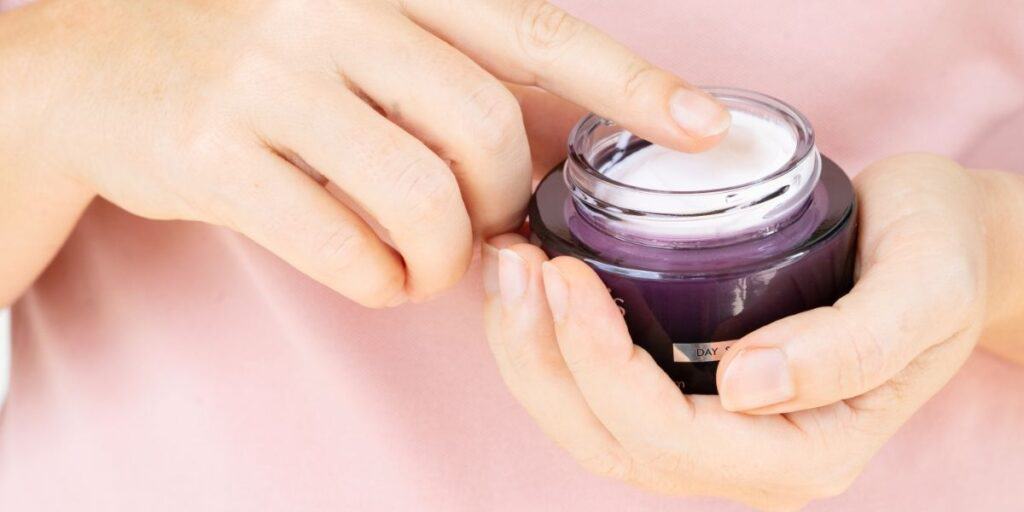Lactic Acid vs Retinol: How To Use for Better Skincare
This site contains affiliate links. I may earn a small commission at no extra cost to you.
Lactic acid and retinol are highly raved-about ingredients in the skincare world, each bringing unique benefits.
So which one is best for you?
Lactic acid, part of the alpha hydroxy acids (AHAs) family, gently exfoliates the skin’s surface.
It removes dead skin cells, unveiling a brighter and more even complexion.

Besides its exfoliating prowess, lactic acid is notable for its hydrating qualities, which set it apart from other AHAs.
Retinol, a vitamin A derivative, operates deeper in the skin. It’s renowned for enhancing cell turnover and diminishing the appearance of fine lines and wrinkles.
Retinol is an antioxidant that protects against environmental damage, contributing to its anti-aging reputation. However, unlike lactic acid, retinol doesn’t offer exfoliating benefits.
Integrating lactic acid and retinol into a skincare regimen can provide a holistic approach, addressing surface-level skin renewal and deeper cellular repair.
This combination delivers comprehensive results, targeting a variety of skin concerns, from fine lines to uneven skin tone.
However, it’s crucial to understand the proper layering and usage of these potent ingredients to avoid irritation and achieve the best results.
Understanding Lactic Acid and Retinol
In skincare, lactic acid and retinol are celebrated for their distinctive benefits. Lactic acid is an AHA known for exfoliation, while retinol, a form of vitamin A, is revered for anti-aging properties through cell turnover enhancement.
Essential Properties of Lactic Acid
Lactic acid belongs to the Alpha Hydroxy Acids (AHAs) family, derived from natural substances such as milk. Here’s what it offers:
- Exfoliation: Lactic acid helps in shedding dead skin cells from the surface layer, promoting a smoother skin texture.
- Moisturization: Unlike other AHAs, lactic acid is also known for its moisturizing effects on the skin.
- Collagen Production: Regular use can stimulate collagen, aiding in reducing fine lines and wrinkles.
Products like those from The Ordinary highlight lactic acid’s accessibility in skincare routines.
Fundamentals of Retinol
Retinol, on the other hand, is a derivative of Vitamin A, highly regarded for its anti-aging effects:
- Cell Turnover: It accelerates the natural process of cell regeneration, helping the skin to renew itself more quickly.
- Anti-Aging: Retinol is an effective treatment for improving the appearance of fine lines and promoting a more youthful look by enhancing collagen production.
Retinol should be introduced gradually into a skincare regimen to minimize potential irritation.

Comparative Analysis of Benefits
Lactic Acid: Hydration and Gentle Exfoliation
- Exfoliation: Lactic acid is an alpha-hydroxy acid that removes dead cells from the skin’s surface and enhances texture.
- Moisturization: Unlike other AHAs, lactic acid also offers moisturizing effects, contributing to a more hydrated and plump appearance.
- Collagen Production: Regular use of lactic acid products stimulates collagen, reducing the appearance of fine lines and wrinkles.
Lactic acid not only exfoliates but also acts as a humectant, which helps the skin retain moisture, improving skin texture. This characteristic of lactic acid can result in a smoother skin surface, offering a subtle glow and an even skin tone.
Retinol: Anti-Aging and Cell Renewal
- Cell Turnover: Retinol boosts the natural cell regeneration process, rapidly rejuvenating the skin.
- Anti-Aging: Known for improving fine lines and wrinkles, retinol enhances collagen production, yielding a firmer skin texture.
- Combatting Free Radicals: As an antioxidant, retinol protects the skin from environmental damage.

Retinol’s antioxidant properties allow it to penetrate the skin deeper. By promoting the proliferation of new skin cells and assisting in fading dark spots, retinol can considerably even out skin tone and refine the skin’s overall texture.
Addressing Skin Concerns
Retinol is highly regarded for its effectiveness in treating acne and reducing redness. It operates by unclogging pores and promoting cell turnover, thus minimizing acne breakouts. Additionally, retinol’s anti-inflammatory properties can reduce redness associated with acne.
However, users should note that sun protection is essential when using retinol products, as they can increase the skin’s sensitivity to sunlight.
When choosing skincare products, particularly lactic acid or retinol, it’s critical to consider specific skin concerns such as acne, sensitivity, hydration, and exfoliation.
Both retinol and lactic acid can assist in exfoliating dead skin cells, but they differ significantly in their approach to hydration.
Lactic acid, a humectant, attracts water into the skin, helping alleviate dryness.
Conversely, retinol does not provide the same hydrating benefits and may cause peeling or dryness, necessitating extra moisturizing efforts. Lactic acid might be the most suitable choice for users looking for exfoliation and hydration.
Incorporating Lactic Acid and Retinol into Your Skincare Routine
When adding actives like lactic acid and retinol to one’s skincare routine, it is crucial to understand their correct application, potential side effects, and suitable product choices to ensure safety and effectiveness.
To integrate lactic acid, an alpha-hydroxy acid, users may start with a lower concentration and apply it once or twice a week as an exfoliator. As the skin builds tolerance, frequency can be increased, always followed by a moisturizer to aid in hydration.
When it comes to retinol, begin incorporating it into your routine with small amounts in a serum form, gradually incorporating it into the nightly routine. Since retinol increases skin cell turnover, it helps rejuvenate the skin.

Using these ingredients separately is essential, and one should be introduced at a time to monitor skin response.
Both lactic acid and retinol can make the skin more susceptible to sun damage due to their exfoliating properties and the acceleration of cell turnover. Sunscreen with at least SPF 30 is essential during the day, significantly, as both ingredients can increase sun sensitivity.
Embarking on a skincare journey, especially with active ingredients like lactic acid and retinol, can be transformative. To help you get started, here are some recommended products known for their efficacy and gentleness, suitable for beginners and those with sensitive skin.
Lactic Acid Product Recommendations
1. The Ordinary Lactic Acid 5% + HA: A perfect choice for beginners, this gentle lactic acid toner is designed to exfoliate the skin delicately while providing hydration. It’s an excellent way to introduce lactic acid into your skincare routine without overwhelming your skin.
2. Sunday Riley Good Genes All-In-One Lactic Acid Treatment: For those ready to step up their lactic acid game, Sunday Riley offers a more intensive treatment. This product is renowned for its ability to refine skin texture and is ideal for regular use in your skincare regimen.

Top Retinol Products to Transform Your Skin Routine
1. Murad Retinol Youth Renewal Serum: Murad’s Retinol Youth Renewal Serum is a standout choice for anyone looking to fight the signs of aging with science-backed ingredients. Its innovative formula delivers the age-defying benefits of retinol and uses a unique technology that minimizes irritation, making it suitable for various skin types. This serum promises to rejuvenate the skin by targeting fine lines and deep wrinkles, offering a smoother, more radiant complexion.
2. La Roche-Posay Retinol B3 Serum: Ideal for retinol beginners, especially those with sensitive skin, La Roche-Posay’s serum blends efficacy with gentleness. It’s a fantastic entry into the world of retinol, minimizing the risk of irritation while delivering visible results.
3. Alpha-H Skin Care 0.5% Retinol with Evening Primrose Serum: For those ready to level up their retinol game, this Alpha-H formulation strikes a perfect balance. The 0.5% retinol potency is boosted by the calming properties of evening primrose, offering a powerful yet soothing treatment for more resilient skin.
Tips for Incorporating New Products
– Check for Allergens: While these products are reputable and carefully selected, individual skin preferences and sensitivities vary. Always review the ingredients list for potential allergens.
– Slow Integration: Introduce new products gradually and one at a time into your skincare routine. This approach allows your skin to adjust and helps you identify adverse reactions to specific ingredients.
– Monitor Skin’s Response:
Keep in mind that the path to ideal skin varies for each individual. The products suggested here serve as a foundational guide. Tuning into your skin’s needs is crucial, making it a better choice to tailor your skincare routine as necessary for optimal outcomes. Everyone will discover that the right products for their skin might differ from what works for others.
Potential Side Effects of Lactic Acid and Retinoic
A board-certified Dermatologist would recommend starting with low concentrations of lactic acid or retinol to assess skin tolerance when incorporating them into a skincare regimen. Pregnant women, however, are often advised to avoid retinol and consult their healthcare provider before using any active ingredients.
Frequency of use and product choice should be tailored to individual skin types and concerns.
For example:
- Beginning with lactic acid, start with twice a week and gradually increase to daily use if necessary and well tolerated.
- Introduce retinol with a once-a-week application before bed and adjust as the skin builds tolerance.
Conducting a patch test is a great way to preemptively identify potential irritation and ensure you select the right skincare products for your unique needs.
Sensitive Skin Types and Lower Concentrations
For sensitive skin types, using products with lower concentrations of active ingredients is often the best way to avoid side effects. If you are new to acids, a lower concentration of acids or gentler acids like malic or mandelic acid can provide similar results without causing skin irritation.
Common Concerns Addressed
FAQs:
- Can lactic acid and retinol be used together?
- They can be used in the same routine but not simultaneously. Apply lactic acid in the morning and retinol in the evening.
- What are the benefits of these ingredients?
- Lactic acid acts as a gentle exfoliant, while retinol is an antioxidant promoting cell turnover and collagen production.
- Are there products that combine both lactic acid and retinol?
- Yes, some products cautiously combine both and are formulated to minimize irritation.
- What should individuals avoid when using these ingredients?
- To prevent over-exfoliation and irritation, it is recommended that BHAs such as salicylic acid and highly concentrated vitamin C serums be avoided in the same routine.
- Are these ingredients safe during pregnancy?

Alternative Ingredients and Combination
While pairing lactic acid and retinol yields benefits, incorporating alternatives or additional ingredients can enhance a skincare regimen.
Niacinamide is a versatile ingredient. It supports skin barrier function and boosts tolerance to retinol.
Hyaluronic acid is an excellent complement to both actives for extra hydration. Products from brands like The Ordinary offer a range of these targeted ingredients, making it easier for consumers to tailor their skincare to specific needs.
Your Skin Journey Is Personal
Remember that skincare is deeply personal. What works for one may not work for another. Always listen to your skin and adjust your skincare regimen as needed.
Always introduce new products slowly to assess tolerance and patch-test new combinations.
The right combination of acids and a consistent routine can significantly improve your skin’s health and appearance.





